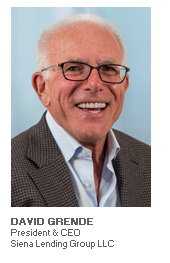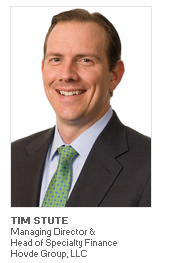
In this installment of our series “Executive’s Corner,” featuring guest writer Charlie Perer of SG Credit Partners, the author sits with David Grende, CEO of Siena Lending Group, and Tim Stute, Managing Director and Head of Specialty Finance of Hovde Group, to discuss their backgrounds in the industry, their views on the current M&A environment, and why now was the time to sell.
Charlie Perer: Thank you for your time gentlemen. To start, can each of you please tell us a little about your backgrounds?
David Grende: My introduction to the industry was completely accidental. I answered a few ad placements at the college recruiting center, one of them being a placement for an assistant account executive at Trefoil Capital, a commercial finance company—whatever that was. Trefoil Capital became Fidelcor Business Credit, which then became CIT Group Credit Finance. I had worked my way up to running the small ABL business of CIT Group. Most trajectories are not a straight line up with successes at each step; mine wasn’t either.

In 2006, I was approached to start an ABL business for Burdale Capital in the U.S. as a Bank of Ireland company. When our U.S. business, alongside the UK business, was sold to Wells Fargo, I was told by senior Wells employees that, if the team could find equity, they would be happy to provide a leverage facility to start an independent finance company. That gave me and my colleagues (six of us) the tailwind to go down the road and keep plugging away until we succeeded in raising equity for a relaunch. And so became Siena Lending Group.
Tim Stute: I’ve spent the last year and a half serving as head of specialty finance investment banking at Hovde Group, a 30-year old boutique focused on the financial services sector. This is my second gig working in specialty finance M&A and corporate finance after spending 16 years at Milestone Advisors and Houlihan Lokey, after the latter acquired the former. My team advises a wide variety of bank and non-bank clients on specialty finance M&A transactions, capital raises, valuations, fairness opinions and other miscellaneous advisory assignments. Since 2004, I’ve been part of the team that’s advised on the most specialty finance M&A transactions in the U.S.
Perer: We are here today to talk about the M&A markets and Siena’s sale to Benefit Street. Dave, to start, what made you and your board decide to sell now?
Grende: The sponsor and Board did not have a sale in mind when Hovde was engaged. The assignment was to raise additional equity for continued growth of the business. As we were going through the process, it became clear to me that a control sale was Siena’s best option for the future. Raising the equity we desired, coupled with our sponsor’s desire to retain control, was an almost impossible outcome to achieve. That, along with the transaction terms put forth, as well as the financial strength of Benefit Street, made it an easy decision for the management team and ultimately for our sponsor and Board as well.
Perer: Dave, did market cycle timing play a role and did you have any preconceived notions about what you and your team wanted in a new partner? Did you accomplish what you set out to when you founded Siena?
Grende: Market conditions certainly played a role but as I stated before there was also a need for us to strengthen our balance sheet for the future. From inception, we had optimized our balance sheet to the point that it could no longer be optimized without new equity. The team’s desire at the outset was to find a partner that understood our space, was going to continue to let us run the business as we had for the past six years, and had the capital resources so that we did not need to worry about capital going forward. To that end, asset managers, credit funds and BDC’s fit those parameters. In regard to accomplishments, we have built a great company around great people who enjoy working with and challenging each other and it is like a family, which was my goal from the onset. However, there is much left to be done as we continue to build the business responsibly to the next level.
Perer: What strategy did both of you come up with in terms of marketing Siena? Were either of you predisposed to a bank or BDC/credit fund? Which constituency seems to be more active now in the market?

Stute: As Dave mentioned, my group was actually engaged to find a minority equity partner that could inject growth capital into Dave’s company as they continued their impressive growth. I ran that idea by Benefit Street Partners, and they considered it. But in the end, their preference was to do a control transaction. We never spoke to a single bank about the acquisition. Banks have always been fantastic acquirers of commercial finance companies, but not anymore. I find it to be really challenging to find a bank that understands the brand of asset-based lending that Siena and its peers are involved in. By that I mean, the sub $20 million credit line deals that price with all in double digit yields. They generally judge the borrowers as if they’re run of the mill C&I borrowers which isn’t accurate or fair. To me, the BDCs and credit funds are where you’ll continue to see more activity. There is a desire among that group to diversify into other products. They have other lending programs and a large customer base of both direct borrowers and sponsors to call on. Adding ABL to the product offering makes a lot of sense.
Grende: Our strategy was very simple, just tell our story. Siena was a restart with the core management team of Burdale U.S., an ABL business we started for Bank of Ireland in 2006. Because of the forced deleveraging of Bank of Ireland’s balance sheet, that business was sold to Wells Fargo in 2012. The core management team of Burdale started Siena in 2012 with financial sponsor backing and a leverage line from Wells Fargo. Since inception, we have focused on the lower middle-market, transacting over 100 transactions totaling more than $1 billion in credit facilities, maintaining excellent credit metrics and excellent financial metrics.
The team, sponsor and Board were keenly aware that a bank was the wrong answer for our business, and so, yes, we were predisposed not to look at that segment at all.
Perer: What are buyers looking for most in an acquisition – yield, platform, team, etc. and what key attributes drive purchase price? How competitive was the acquirer interest in Siena and is that indicative of the demand for ABL platforms in today’s market?
Stute: In commercial finance, we find that the quality and depth of the senior management team and a historical track record of clean credit quality are the biggest drivers of value. Those attributes need to be accompanied by strong financial results – i.e., attractive return on assets and return on equity – to drive value. But good financial metrics are somewhat meaningless without the institutional backbone that a deep, experienced team who’s weathered various downturns can provide.
Perer: Where are we in the demand cycle for ABLs and what surprised you most about the prospective acquirer interest in this process? Also, is now a time to start a de novo platform? We are top of the market and many incumbents will have portfolio issues during next downturn?
Stute: Yield continues to be tough to find across most segments of lending. In addition, the competition for quality loans in all asset classes is at or close to an all-time high. That contributes to high demand for ABL companies that fit the characteristics laid out above. That said, I’d be cautious about starting a de novo lending business today. I would think it’d be hard to profitably build scale in this competitive of an environment. That said, I do feel strongly that when we do hit another downturn, those with access to capital are going to be best positioned to exploit opportunities, both organically and by acquisition as finance companies with fickle capital providers are left looking for new partners.
Perer: What was it about Benefit’s platform that made Siena go with them? What is it like to be on the receiving side of a diligence list when you are busy running a business?
Grende: The transparency and openness of the senior leaders, as well as their creativeness and focus to keep moving “the ball down court” despite many obstacles that occurred during the process. Couple that with their size, the size of their new parent, Franklin Templeton, and the decision was not that difficult.
Our CFO and CRO did most of the heavy lifting on the diligence and I can’t thank them enough because the deal wouldn’t have gotten done without their work.
Perer: Tim, how many ABL consolidation cycles have you been through and is this one different due to the outsized role that BDCs and credit funds are playing? Are they making life difficult for traditional bank acquirers?
Stute: This long cycle we’ve been in since the beginning of the decade is really only the second material consolidation cycle I’ve been a part of. Before the recession, from 2003 to 2008, we saw a lot of M&A activity in this space and it was then that my old firm, Milestone, started to play a meaningful role in the sector. You’re right that this cycle is quite different from the last one because of the BDCs and credit funds. Before the recession, most buyers were banks. As I mentioned before, banks are still active players for these businesses, but they have to be almost a perfect fit credit quality-wise for a bank to get there in the end. From that standpoint, I’m actually quite thankful that the BDCs have emerged as such a force because it’s given my team a reliable option to pursue for our clients.
Perer: Why is ABL in such high demand in the market right now? What is driving the demand from both strategic buyers i.e. banks and BDCs/credit funds? Why are these platforms critical to such different constituencies?
Grende: ABL today has become a mainstream financial product. From a bank’s perspective, it sits at the top of a capital stack, has very low risk, and brings with it all the ancillary products and income they desire; bond fees, cash management, insurance, swaps, etc. From a non-bank perspective, the product has a great yield, variable rate, very low loss given default ratio, is counter cyclical, working best in out of favor industries and slumping economic conditions. This makes it ripe to fit into credit funds and BDC’s.
Stute: I would just add that oftentimes with banks that are attracted to ABL, they can be interested in adding more management team depth that also helps them get into another segment of the market. For example a bank with expertise in the lower yielding, $20 million+ facility market may find it appealing to add higher yielding loans in the smaller loan market. Or a bank might see strategic value in getting into a particular niche like staffing or transportation.
Perer: Tim, do first-time ABL acquirers fully understand the risks and the dynamics of the ABL product? What are some mistakes you have seen?
Stute: I think in most instances the buyers getting into ABL for the first time have a comprehensive understanding of the product and the market. But I can think of a few instances where I’d argue that a bank buyer maybe didn’t fully appreciate the “roll up your sleeves” diligence and collection work that is required sometimes to be successful in ABL. The vast majority of M&A transactions I’ve been involved in have been a success for both buyer and seller. The less successful transactions have generally stemmed from the buyer’s unwillingness to leave the target’s operations, credit policies, and culture in place. A pure portfolio deal is a different story. But if you’re buying a platform and presumably paying a meaningful premium to get the deal done, then I think it’s foolish for the buyer to come in and add layers of bureaucracy that will in turn drive the talent away from the organization, or at least make it more difficult to close loans in a timely fashion.
Perer: Dave, how do you see the ABL market evolving given the consolidation that has taken place? Do you have any strategic changes planned?
Grende: I see the larger banks going down market size wise, doing smaller deals they previously shunned. Smaller banks will continue to get into the space operating with small teams providing another product alternative to their customers. The non-bank ABL players will get a great boost from the next credit downturn with the non-scaled weaker players going through a shakeout.
Perer: Can you two give the readers the most memorable part of the process?
Grende: Closing finally! Second was the review of our watch list accounts with the Investment Committee of Benefit Street. This occurred a week before closing and reviewing only your more challenging accounts is never an uplifting meeting.
Stute: Some of the most memorable parts of the process need to be kept confidential unfortunately. But I will say that Dave and his shareholders had significant interest from some of the most well-known institutional investors in the market, and I suspect that some of them are not used to losing many deals. So negotiating simultaneously with all of these groups was fun, albeit a bit stressful.
Perer: Gentlemen, last question, what is next trend in ABL that the market has yet to embrace?
Grende: Intellectual Property lending.
Stute: I wish I knew! The ABL market generally is not one that has embraced technology as much as some other commercial finance sectors like equipment lending and leasing. But there are definitely a handful of players that are trying to use technology to enable more efficient lending, but only a small handful. I think more private lenders are going to get into cannabis lending. Some players have started to look at it more closely, and I see more commercial lenders embracing the sector going forward.